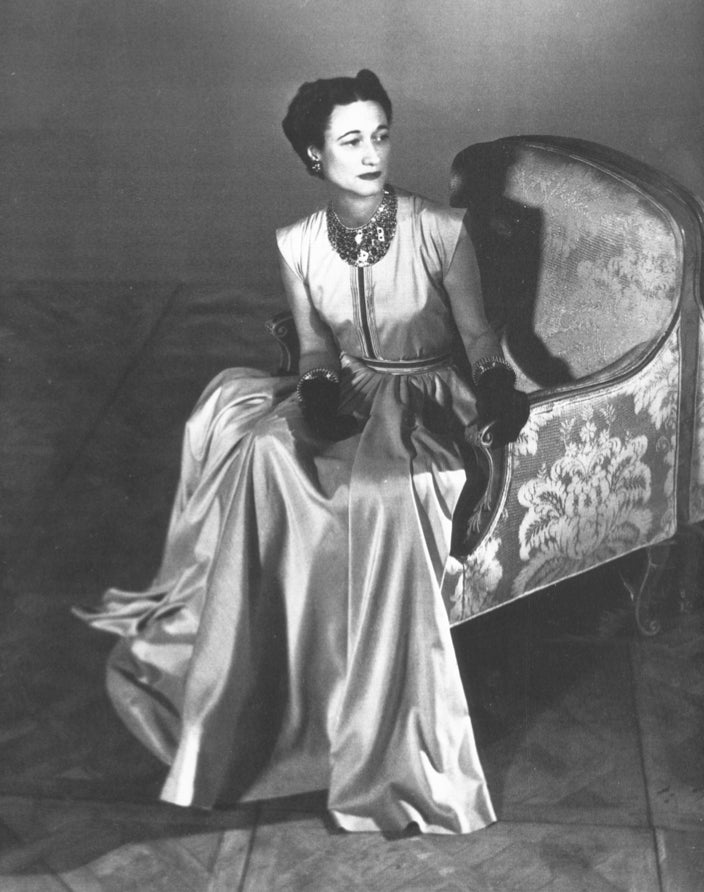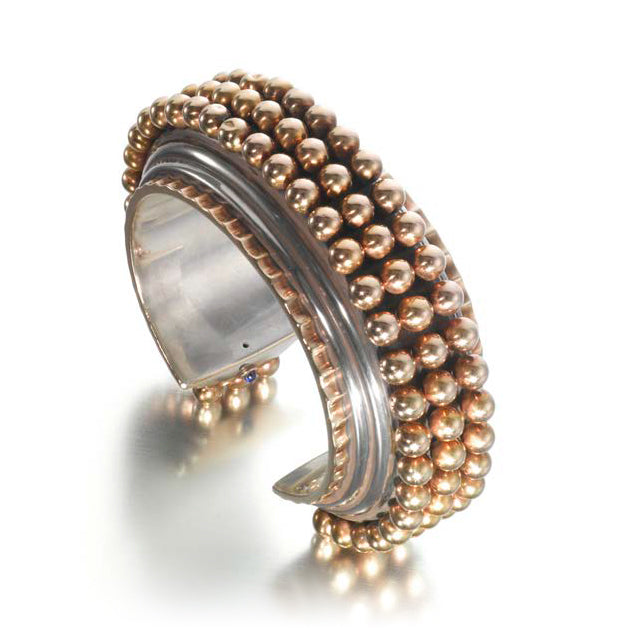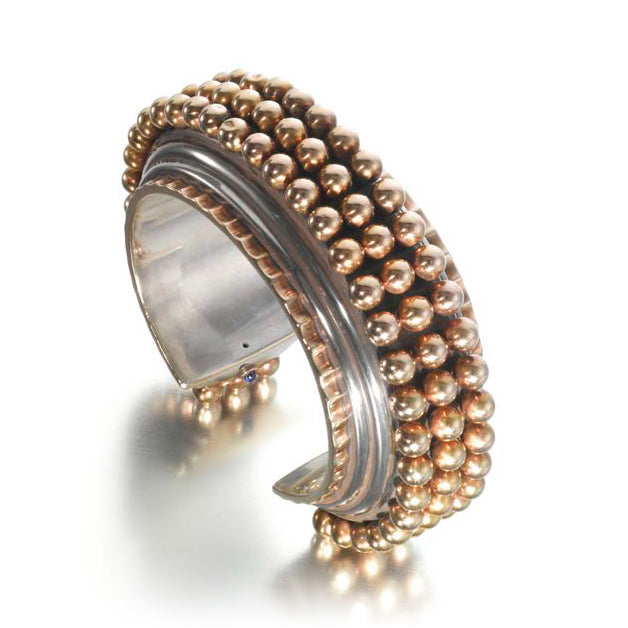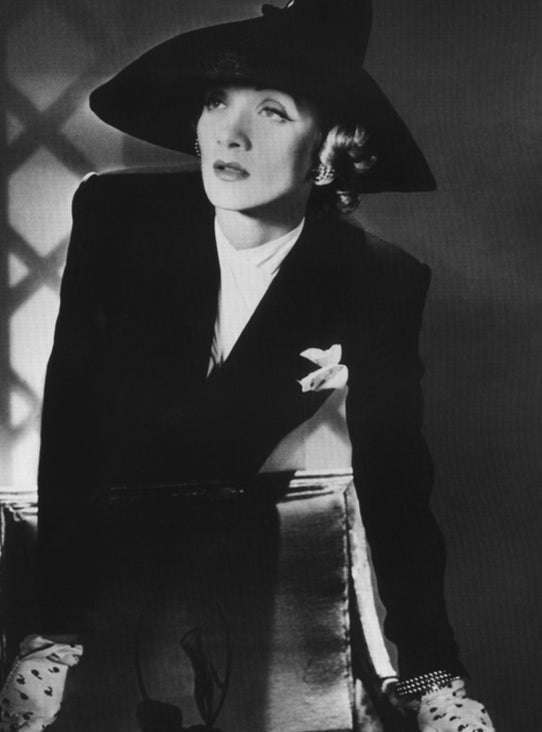
Wallis, Duchess of Windsor photographed by Horst P. Horst in the 1940s wearing a Mainbocher silk shantung dress with a Cartier necklace and cuffs in the style of the bracelet on offer. Prince Edward, Duke of Windsor, purchased the pair for the Duchess during the War, when they moved to Nassau. He added the hopeful inscription, “For a happier new year NASSAU 1-14-41 WE.”
ART MODERNE SILVER, GOLD, AND SAPPHIRE CUFF BRACELET BY CARTIER, NEW YORK, CIRCA 1940
ART MODERNE SILVER, GOLD, AND SAPPHIRE CUFF BRACELET BY CARTIER, NEW YORK, CIRCA 1940
SOLD: Acquired by the Cartier Collection
A wide silver cuff with a crenulated and gilded top surmounted by a stepped, double-fluted silver band; the top is set with three rows of gold spheres; the cuff opening has cabochon sapphire accents; mounted in silver and gold
- Signed on cuff opening Cartier
- Measurements: 3 1/4 × 3 3/4 × 1 1/4 inches
Additional cataloguing
Certification
- Cartier Certificate of Authenticity, no. GE2009-154, dated June 10, 2009, stating the bracelet is “Cartier New York, circa 1940.”
Literature
- cf. Colero, Nadine. Amazing Cartier: Jewelry Design since 1937. Paris: Flammarion, 2009, p. 128.
- cf. Culme, John, and Nicholas Rayner. The Jewels of the Duchess of Windsor. New York: The Vendome Press, 1987, pp. 174, 176.
- cf. Mouillefarine, Laurence, and Évelyne Possémé. Art Deco Jewelry: Modernist Masterworks and their Makers. London: Thames & Hudson, 2009, p. 229.
Biography
Cartier was founded in Paris in 1847 by Louis-François Cartier. His three grandsons, Louis, Pierre, and Jacques, built the house into a famous international jewelry empire serving royalty, Hollywood stars, and socialites. Cartier has created some of the most important jewelry and objects of art of the twentieth century with many iconic designs such as mystery clocks, Tutti Frutti jewelry and the Panthère line. In 1983, The Cartier Collection was established with the objective of acquiring important pieces that trace the firm’s artistic evolution. Today, Cartier has 200 stores in 125 countries.
Significance
The name Cartier is synonymous with superb jewels; jewels that often defy the parameters of a particular style or period. Although the company’s jewelry is traditionally associated with important gemstones, Cartier also created artistic pieces, such as this bracelet, that were more about design than materials. This machine-style piece was created at a time when art and design were influenced by the perception of the machine as a combination of gears, cams, and axles as exemplified by the paintings of Charles Sheeler, who created true-to-life depictions of motors, stacks, and parts. The new style, called Moderne, was a response to the acknowledgement of the machine as an inspiration for decorative arts. All trace of romanticism or whimsy had disappeared, replaced with a sense of geometry.
This cuff bracelet epitomized this new direction with a composition more like a part of a machine than a conventional piece of jewelry. It is designed with crenulated borders on both sides and a stepped fluted band elevating the center section set with three rows of gold spheres. All Cartier jewelry from this period was made in New York, where the Paris salon relocated for the duration of World War II.
The bold design of this cuff bracelet appealed to self-assured women and the men who gifted them such a treasure. This bracelet was designed for customers who understood jewelry was about design and wore it for its aesthetic fascination. Two of the most noted jewelry collectors and style icons of the first half of the twentieth century owned this cuff bracelet. Edward, Duke of Windsor, presented a pair to Wallis, Duchess of Windsor, at the end of 1940, just after they moved to Nassau. It was a token of his love for her and the hope of a better life away from the travails of war as embodied by the inscription, “For a happier New Year NASSAU 1-1-41 WE.” Another celebrated trendsetter, actress Marlene Dietrich, was given one by the French actor and military hero Jean Gabin. Both women wore their cuff bracelets while being photographed by the celebrated photographer Horst B. Horst. Dietrich’s picture appeared in Vogue, July 1, 1942. Cartier created a cuff bracelet that is not only a work of art but is also a striking arm ornament that is sure to be the center of attention when worn.

Wallis, Duchess of Windsor photographed by Horst P. Horst in the 1940s wearing a Mainbocher silk shantung dress with a Cartier necklace and cuffs in the style of the bracelet on offer. Prince Edward, Duke of Windsor, purchased the pair for the Duchess during the War, when they moved to Nassau. He added the hopeful inscription, “For a happier new year NASSAU 1-14-41 WE.”







